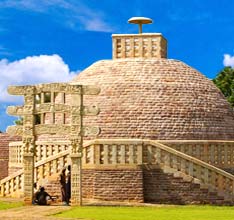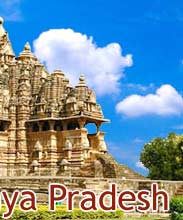 Location:
Central India
Location:
Central IndiaMadhya Pradesh claims a position of prominence as the second largest state of India, with Rajasthan being the first. Earlier, the place was deemed as the largest state of India, before Chhattisgarh was carved out of it. Literally, Madhya Pradesh means 'Central Province'. It is an apt name, as the state is exactly located in the center of the Indian map. The entire state of Madhya Pradesh stretches for miles and covers a total area of 3,08,144 sq km. Today, Madhya Pradesh borders the neighboring states of Uttar Pradesh, Chhattisgarh, Maharashtra, Gujarat and Rajasthan.
On the west of Madhya Pradesh lies Gujarat; on the northwest is Rajasthan, on the northeast is Uttar Pradesh, on the east is Chhattisgarh, and on the south lies Maharashtra. The state can be geographically segregated into various regions, based on the distinct cultures and languages of these areas. For example, Malwa plateau falls in the north-west of the state, north of the Vindhya Range. Nimar (Nemar) is the western portion of the Narmada valley and is positioned south of the Vindhyas, in the southwest portion of the state. The fecund region of Bundelkhand, on the other hand, falls in the northern part of the state.
The northwestern region of the state is Chambal. This mountainous expanse of Chambal is rich in sandstone and was once famous for rampaging pirates. The hilly terrains towards the northeast are home to the Baghelkhand region, which also incorporates the eastern end of the Vindhya Range. Mahakoshal (Mahakaushal) is the southeastern portion of the state and include the eastern part of the Narmada valley and the eastern Satpuras within its realm. Lastly, there is the Central Vindhya and Satpura region, which spreads over most of the central Narmada river valley.
Excluding the valleys of the Narmada and the Tapti, the entire state is perched atop a plateau, at an elevation of 500 m above sea level. Apart from that, another noteworthy geographical feature of the state is its assocation with great river basins and watersheds of the various rivers. The two rivers, viz. the Narmada and the Tapti and their basins divide it into two, and add on to the aquatic charm of the state. To sum it all, it can be said that the topography of Madhya Pradesh clasps every facet of nature. The place bustles with plateaus, plains, ravines and many dramatic slopes that disappear into the darkness of many thick forests.









